New Inventory Item
The New Inventory Item screen allows you to add a new Item to your database and to specify how you want to track each item (by Serial Number, Lot, and/or Date Code).
Items represent the material or goods that you will have in your inventory. The inventory screen captures a lot of information, such as manufacturers, suppliers, units of measure, etc. The item is not part of your inventory until you add quantity and specify a location. The quantity and location are added in the Add Inventory screen.
When setting up your software for the first time, you may want to import your items rather than add them one at a time through this screen. Please refer to the Import Data topic for importing information into your database.
Note: Inventory Items can also be created on iOS and Android devices.
Topics covered in this section are:
Accessing the New Inventory Item Screen
Note: Refer to the Vendor Tab, Prices Tab, Locations Tab, and Attachments Tab in the View/Edit Inventory Item screen is similar to the New Inventory Item screen.
Accessing the New Inventory Screen
Click on Item > New Inventory Item.
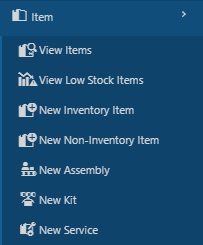
The New Inventory Item screen appears.
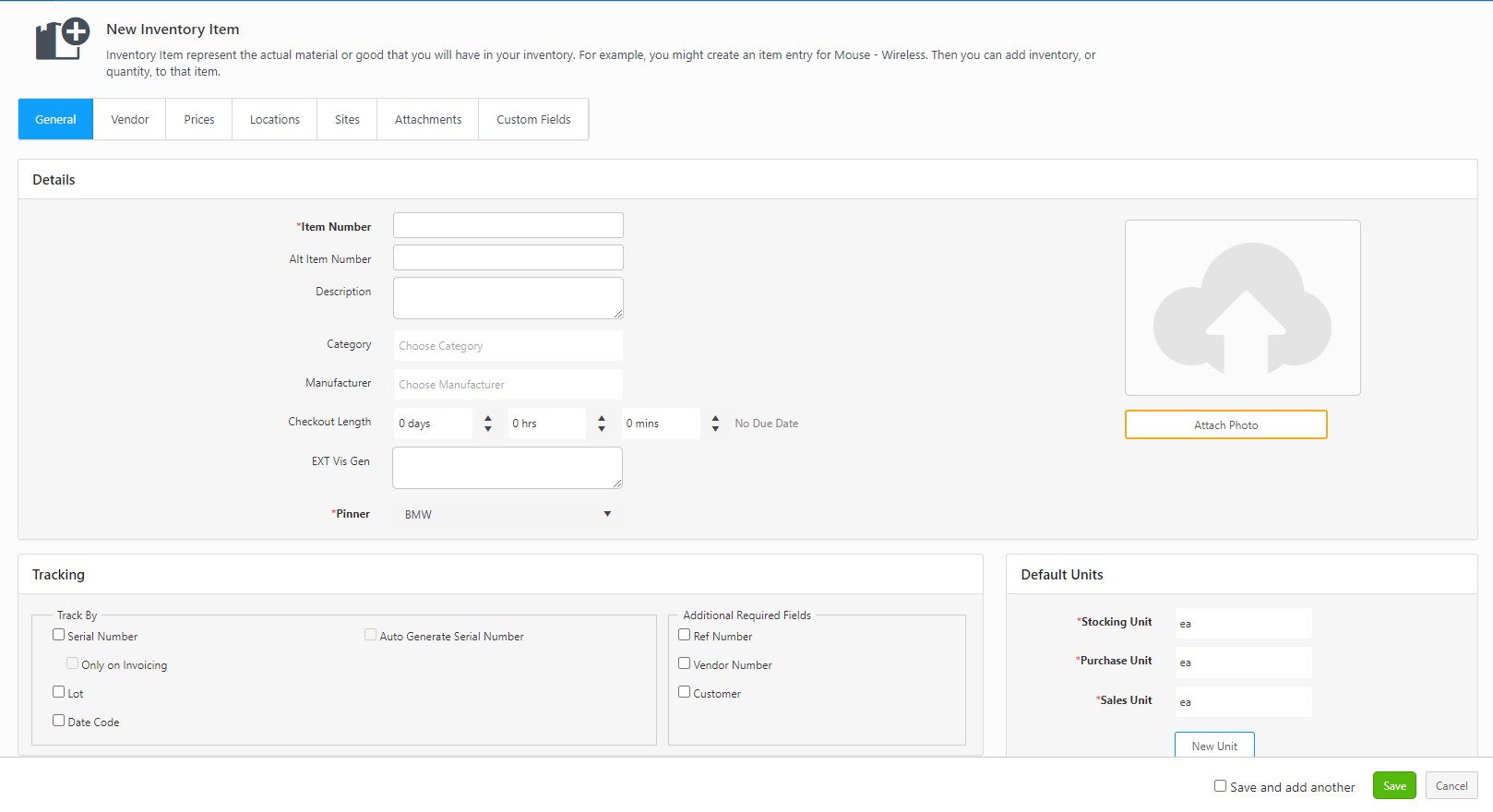
Adding a New Inventory Item
The General Information tab is where you will enter the basic information about the item.
- Item Number (Required) - The Item Number is often available on a barcode label already attached to the item, such as a UPC code or SKU number. Using an existing barcode for the Item Number allows you to scan or manually enter the number from each item as it comes in without having to print and affix your barcode inventory item labels. Item numbers in InventoryCloud cannot exceed 31 characters.
Do not use a description as the item number. You should enter a numeric value in the Item Number field. A description of the item can be entered in the Description field.
Settings topic.
Automatic Item Numbers: If the Automatic Item Numbers option is selected in Settings > Item > Automatic Item Numbers, the Item Number field will appear populated with the following number in the sequence. For example, if you created item 1001, the next number will be 1002. For further information on this option, please refer to the Settings topic.
- Alt Item Number - Enter an alternate item number (optional).
- Description - Enter a description.
- Category - Select the category. The category is an optional classification you can give to your items. It provides you with another way to group your items. For example, you could create a category called laptops and assign that category to any laptop items you have. You might have multiple items representing different makes and models of laptops. If you assign the category "Laptops" to all those items, you can group your list by category and quickly see all laptop items. Categories you have already created will appear on a drop-down list.
- Manufacturer - Select the manufacturer. This is the entity that manufactured the item. This field is optional and provides another way to sort and group items.
- Check Out Length - This field specifies the default period, in days/hours/minutes, that this Item can be checked out to a customer. Enter the value using the arrow up and down button.
- Tracking - The Item To Be Tracked By section contains checkboxes that determine whether an Item's Serial Number, Lot, or Date Code will be used to track its movement through your inventory. For a more detailed explanation of tracking fields, please refer to the topic Identifying Tracking Needs. When creating your item, it is important that you determine how you want to track each item. Typically, small items that are all the same may not need to have any Track Bys selected. Items such as printers may need to be tracked by Serial Number, so returns and maintenance can be properly tracked. Medical supplies or food may need to be tracked by Date Code and/or Lot. If you choose to trackby one or more of these fields, you will be prompted to complete them each time you perform a transaction, such as a check out, move, remove, add, etc., on this item. For example, if you are tracking item 2233 -VZ Laptop by serial number. Now you want to move a quantity of 5 of this item from one location to another. You will be prompted to enter a unique and valid serial number for each laptop you are moving so your inventory can be accurately tracked.
Note: Tracked By options cannot be changed after you add inventory to the item. If you need to change a tracked by item, you will have to remove all inventory from that item, delete the item, and create a new record.
- Serial Number - Serial Numbers must be unique for each item and limit you to managing one item at a time. If the Only on Invoicing checkbox is selected, the Serial Number is only tracked on invoices (not check-ins, check-outs, etc.). Example - Equipment such as printers and radios or anything for which you need to know which specific item you are using.
When you click on the Serial Number checkbox, a text box will appear below the Auto Generate Serial Number. Click on the Auto Generate Serial Number checkbox to generate the serial number automatically. Click the Format button to format the serial number in the Settings > Number Series screen.
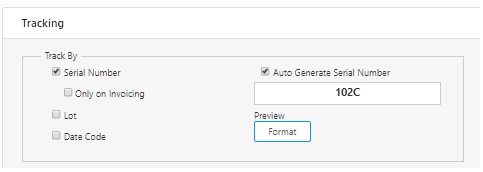
- Lot - The manufacturer provides these numbers to indicate from which batch these items were made. Examples are medical supplies, pharmaceuticals, and food products.
- Date Code - Date Code tracks the expiration or other "use by" date. Example - Food, Chemicals.
- Additional Required Field - This section contains checkboxes that act much like the Tracked By boxes but contain a different set of fields (PO, Vendor, and Customer) which are always available for use, even if they are not required. For example, if the option is not enabled for the Vendor Code field, a user adding inventory can enter a value for Vendor Code if he knows it or skip entering a value if he doesn't. If this option is enabled, a value for Vendor Code is required to complete the transaction.
- Default Units (Required) - The default units section lists how you want your inventory to be stored. These are the Base Unit, Sales Unit, and Purchase Unit. Select a unit of measure from the drop-down for each unit type. You can add a new unit of measure by clicking the New Unit button.
- Stocking Unit - Select the stocking unit. Examples: bag, barrel, basket, block, bottle, box, carton, container, drum, gallon, jar, pack, package, pallet, section, tub, vial, etc. When entering the stocking unit, you need to pick the smallest unit of measure that you will use to remove a whole item. A good test to use when deciding what the stocking unit should be is to think about your answer would be if you were asked to count how many of this item you have. If the answer is 100 feet of rope, "feet or "ft" is the stocking unit. If the answer is 20 scanners, then "each or "ea." is the stocking unit. Each is common when the unit itself is not a standard unit of measure. If the answer is 100 boxes of nails, then "box" or "bx" is the stocking unit. Refer to the topic - How to use Units of Measure of different types
- Purchase Unit - This is the unit of measure used when you buy this item from your vendor. Example - This might be a pallet rather than a box. Refer to the topic - How to use Units of Measure of different types
- Sales Unit - This is the unit of measure used when you sell an item. For example, you may have a stocking unit of Carton that holds 10 boxes of nails but sells them by the box. In this example, the Sales Unit would be the box. Refer to the topic - How to use Units of Measure of different types
- Pricing
- Cost (Required) - Cost specifies the amount your company paid to get this item into inventory. Cost handling in InventoryCloud is designed to show you the average cost and current value of your inventory. You can also use this cost information for other purposes, such as determining pre-tax and purchase order totals and receiving totals. This amount represents your cost for purchasing one of the base units for this item. If one Barcode Laser Scanner costs $300.00, you will enter 300 into the cost field. If you have items in your inventory that are sold in fractional quantities, you will need to decide which stocking unit to use. For example, if you have rope as an item and it costs you $0.12 a foot, you would enter 12 in the Cost field and feet as the Stocking Unit (entered on the Additional tab). If you rarely sell the rope in exact multiples of feet, you may want to enter your Stocking Unit as Inches, since this is the lowest unit measured, and enter your cost per inch in the Cost field. It is up to you how you want to calculate this; however, you should make sure that the Cost you enter is the cost for one whole Stocking Unit (either Feet or Inches, in our example). Keep in mind that you can enter a new cost on the Add Inventory screen if you purchase this item at a discount. For more information on Cost Tracking and Average Costing, please click here.
- Sales Price - This field specifies the price at which you sell an item. This field is for your information only and is not included in any reports. The price entered here is the price that appears in the Price field on Pick Orders.
- Cost Method - Select how you want InventoryCloud to calculate the cost for this item. Options are:
- Moving Average - When this method is used, the average cost of a particular item is recalculated based on each purchase. Cost is calculated on the item level.
- FIFO - When this method is used, the inventory that is added first is removed first. Cost is calculated on the item level.
- LIFO - When this method is used, the inventory that is added last (most recently) is removed first. Cost is calculated on the item level.
- List Price - This field specifies a manufacturer's list price for an item. This field is for your information only and is not included in any reports.
- Average Cost - This is a calculated value that averages the cost paid for the current quantity. This will be blank when you are entering a new item but will appear when you are viewing the Edit Item screen for an item that has inventory (quantity). When calculating the Average Cost, the software does not include records that have an average cost of zero. When you run an Inventory Cost Report, the software does include zero-cost quantities when calculating Total Cost.
- Tax Code - You can optionally select whether this item is taxable or non-taxable.
- Dimensions - Enter the dimensions of the item after selecting the height, weight, and volume units.
- Attach Photo - You can add a photo if required.
- Click on the Attach Photo button. The Attach Files screen will appear.
- Click on the Select Files button.
- Drag and Drop - You can drag a file from a folder in Windows Explorer and drop it into the Attach Files window. Make sure the Select Files area is highlighted before dropping.
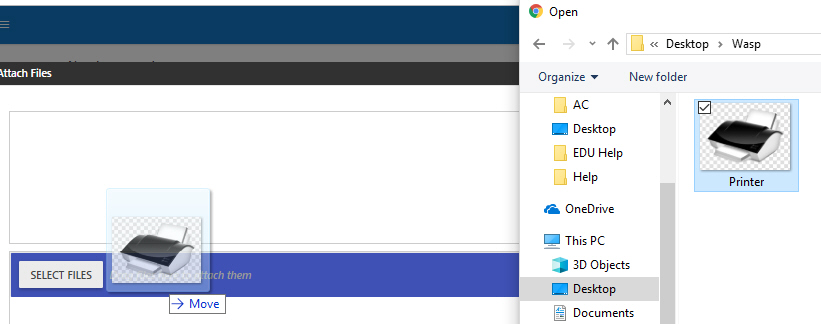
- Select Files - Click the Select Files button to open the standard Windows Explorer window. Navigate to the file you want to add, then click Open. The files you attach will appear in the window:
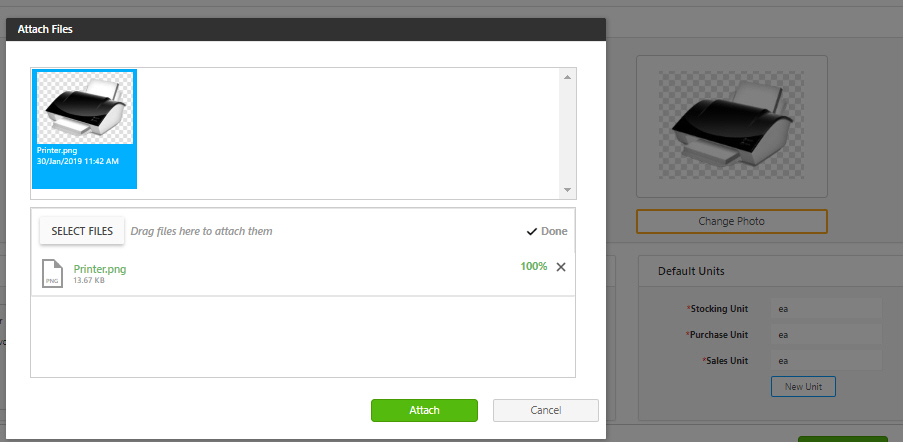
- Click on the Attach button. The photo will appear in the photo section. Click on the Change Photo to access the Attach Files screen and select a different photo.
This tab allows you to identify which vendors you will use for this item and enter detailed vendor information, such as a unit of measure. You can enter multiple vendors for an item and mark one as your preferred vendor.
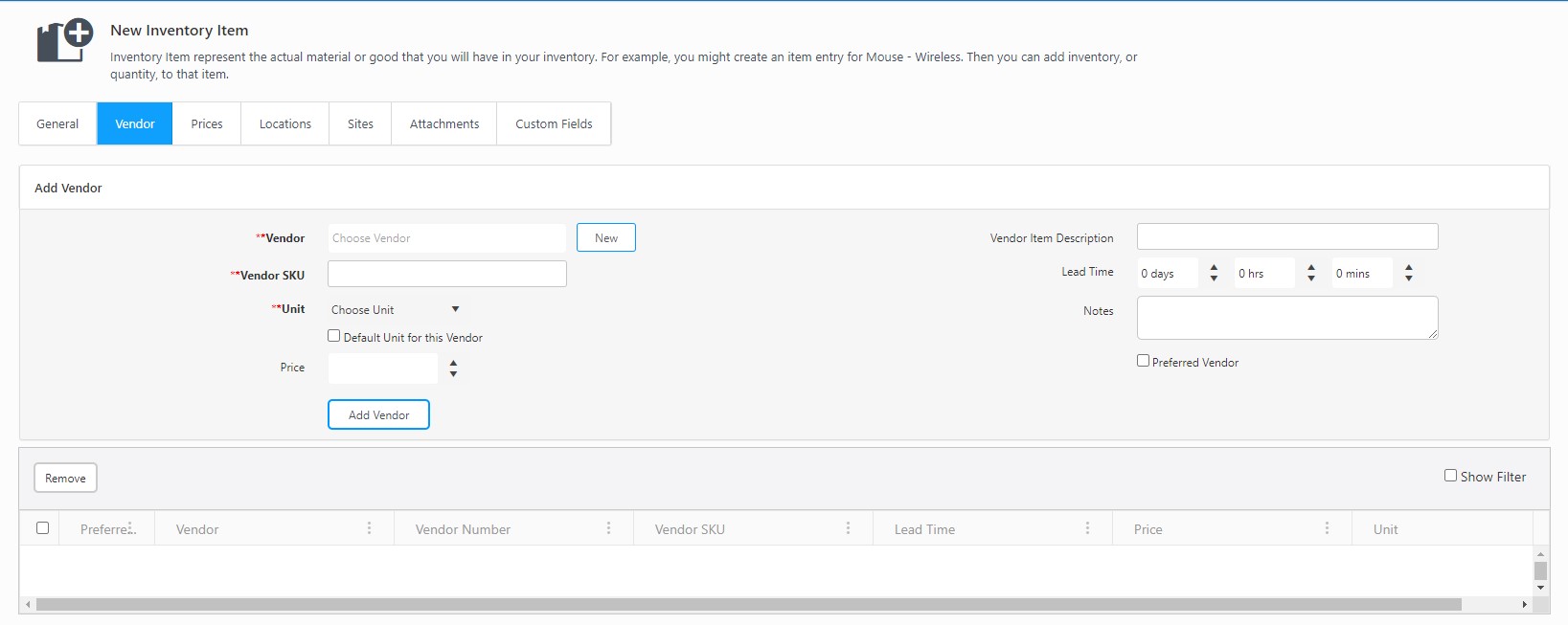
Enter information on the Vendors Tab:
- Vendor - Enter the vendor name (required) or click New to add a new Vendor.
- Vendor SKU - Enter the vendor SKU (required). This is the SKU number the selected Vendor assigns to this item.
- Unit - Select the vendor's unit of measure for this item from the drop-down menu. This is the unit used by the Vendor when shipping this item. This may be a box, pallet, etc. New Units of Measure are entered on Administration > Units of Measure.
- If you are tracking cost and have entered information in the Cost field (General Tab) and in the Stocking Unit field (Additional Tab), when you receive the item, InventoryCloud will do the math and will calculate the cost per item received.
- For example, if you order item Barcode Laser Scanners in boxes of 20 at $3500, but your base unit is each, you need to specify the cost of a box of 20 when you are setting up your Vendor information here. When the item is received, InventoryCloud will calculate the cost per item received. $3500/20 = $175.00.
- You can enter multiple order units if needed. When you are creating your purchase orders you can select which one you want to use.
- Select the Default Unit for this Vendor checkbox if this is the unit you want to automatically appear on purchase orders for this item and Vendor.
- Price - Enter the price that the selected vendor charges for the item per the unit selected by clicking the up and down arrow buttons.
- Vendor Item Description - Enter the vendor Item description.
- Lead time - Enter the lead time or preparation time required by the Vendor to process the checkout of an Item i.e. the time needed before an Item can be checked out after it is checked in. Leave this field at zero to indicate no lead time.
- Notes - Any notes entered for this vendor. You can also add additional notes as needed.
- Preferred Vendor checkbox - You can make a vendor default for a particular item by checking the preferred vendor checkbox. When this is selected, this Vendor will automatically populate purchase orders for this item. You can change the Vendor on the purchase order if needed.
- When you are done entering the information, click on the Add Vendor button. The Vendor will appear in the list at the bottom of the screen.
- Show Filter checkbox allows you to narrow down the displayed results to a range of items or a specific item.

The Vendor from the list can be removed by selecting the checkbox in front of the listing and clicking on the Remove button. You can have more than one vendor.
Tier pricing is a promotional tool that lets you price items differently for different products, categories, or customers. This is an effective way to move more merchandise.
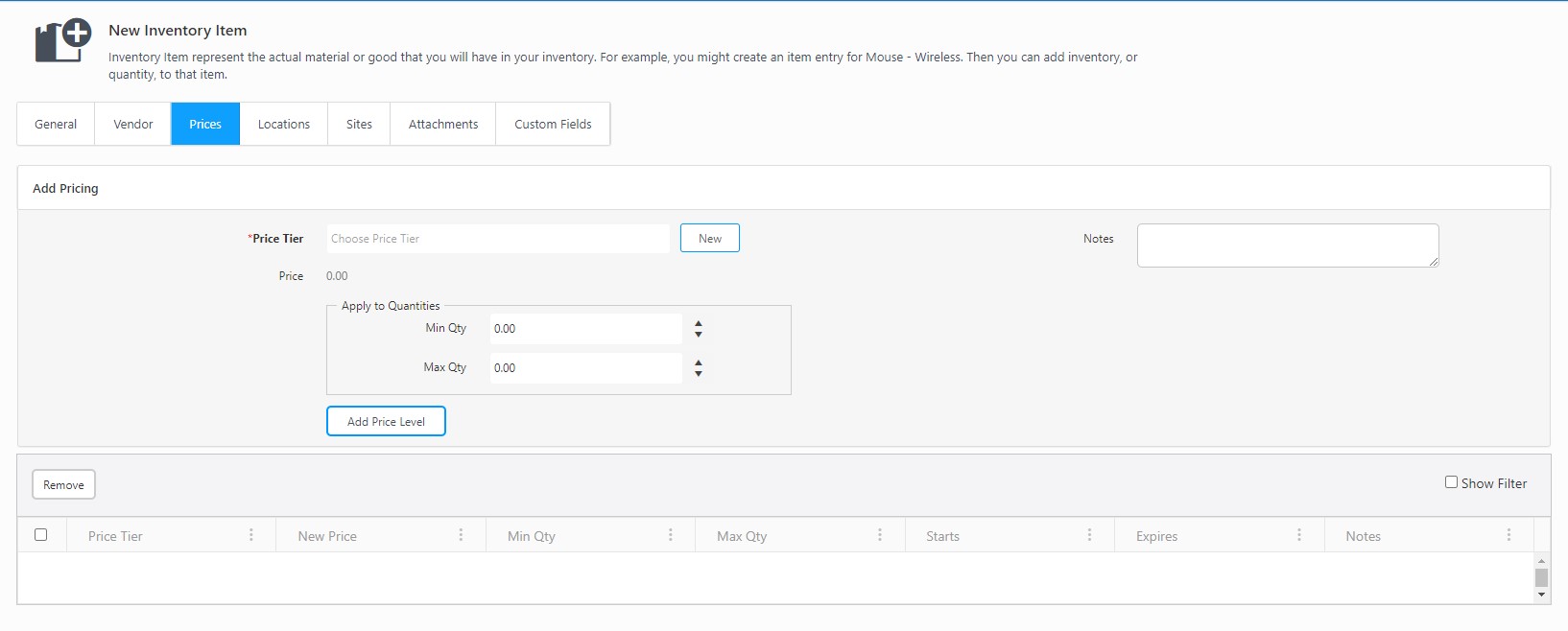
- Price Tier (Required) - Enter the price tier or select the price tier from the drop-down. Click the New button to access the New Price Tier screen.
- Min Qty - Enter the minimum quantity that must be purchased to qualify for this price tier.
- Max Qty - Enter the maximum quantity that can be purchased to qualify for this price tier.
- Notes - Enter any additional information in the notes field.
- Click the Add Price Level button to add the selected price details. The Price Tier will be added to the list at the bottom of the screen.
- Show Filter checkbox allows you to narrow down the displayed results to a range of items or a specific item.

You can remove a Price Tier by selecting the checkbox and clicking the Remove button.
You can assign the item to a specific location.
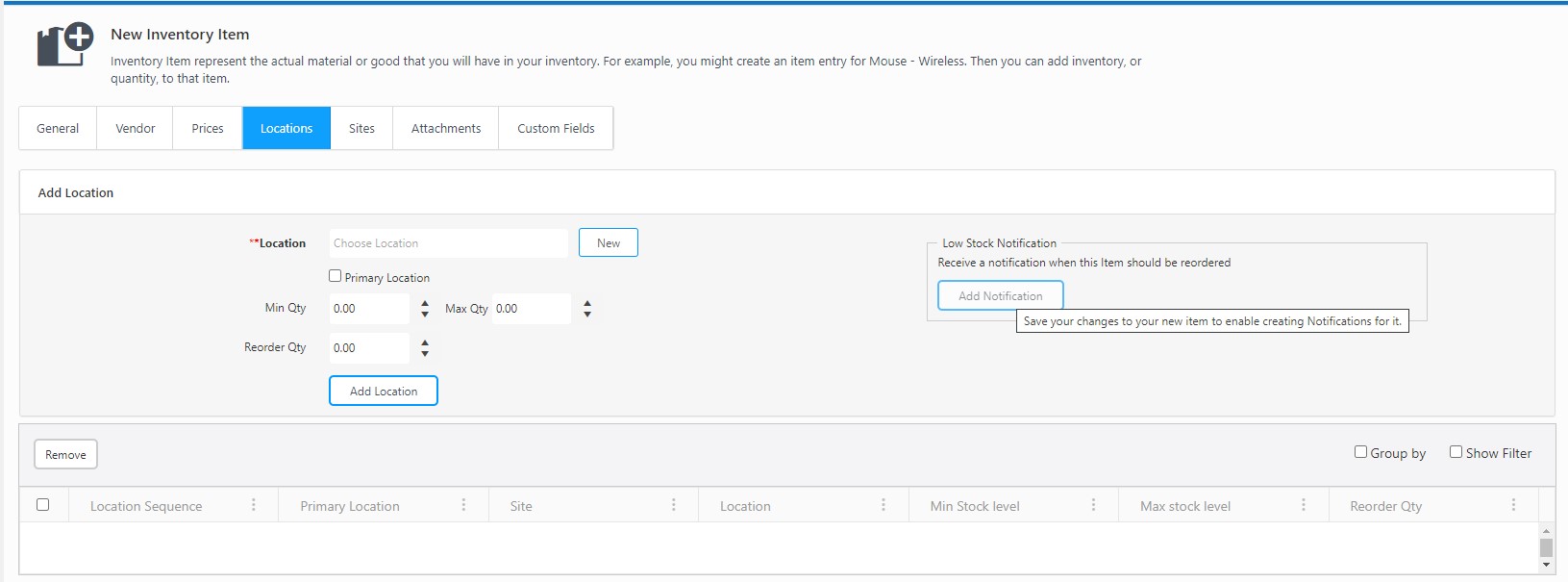
To add a location:
- Location - Choose or enter the location name. You can also add a new location. Click on the New button, which will navigate to the New Location screen.
- Select the Primary Location checkbox if you want this to be the primary location for the item. In this scenario, when you Receive quantities of that item from a purchase order, they will automatically be assigned to the primary location. Also, when you Pick quantities of that item for pick orders, they will automatically be removed from the primary location. You can change these locations when picking and receiving if necessary. In addition, the primary location will appear in any location fields (on the Add inventory screen, for example), however; you can change the location if needed. The location tab will show the Site and Location name on hover.

- Min Qty - Enter the minimum number of items that you want to have "In stock" at the selected location. This number can be 0 or positive; negative numbers are not allowed. Note: The minimum stock levels assigned to these locations will also prompt notifications within the New Purchase Order page when you click on the Reorder Low Stock button.
- Max Qty - Enter the maximum number of items that you want to have "In stock" at the selected location. This number can be 0 or positive; negative numbers are not allowed.
- Reorder Qty - Enter the Reorder quantity. Reorder quantity is the amount that needs to be reordered whenever the item is below the minimum stock level. Refer to New Purchase Order - Reorder Low Stock.
- Low Stock Notification - Add Notification Button - This is used to create an item of low stock notification for a location. If you want to receive a "Low Stock Item" alert, click the Add Notification button and configure the notification.
Note - The Low Stock Notification button will be disabled when creating/adding a new inventory item. On hovering above the notification button, a message will appear indicating, “Save your changes to your new item to enable creating notifications for it.” The user can create a Low Stock Notification alert while editing the item, i.e., the notification button will be enabled on the Edit Inventory Item screen.
- Click on Add Location. You can remove a location by selecting the checkbox and clicking the Remove button.
Use Show Filter to filter the location list and Group By to group the columns in based on your need.
You can assign an inventory item to a specific site.
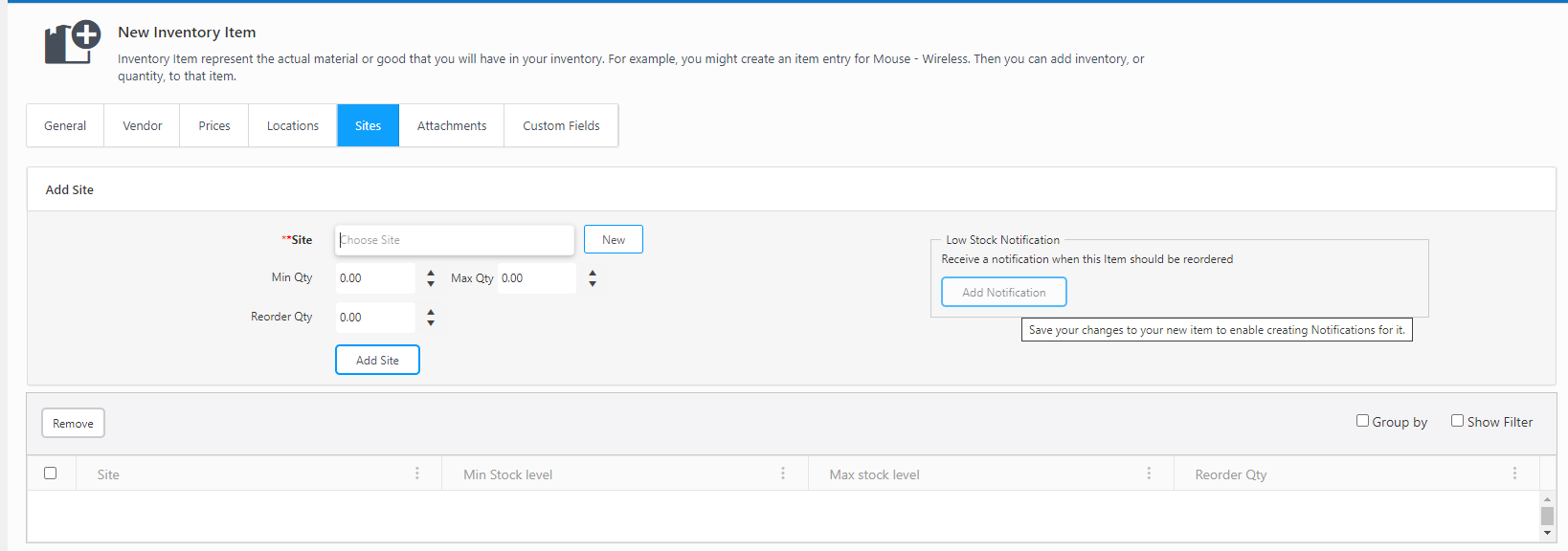
- Site - Choose or enter the site name. You can also add a new site. Click on the New button, which will navigate to the New Site screen.
- Min Qty - Enter the minimum number of items that you want to have "In stock" on the selected site. This number can be 0 or positive; negative numbers are not allowed.
Note: The minimum stock levels assigned to these sites will also prompt notifications within the New Purchase Order page when you click on the ‘Reorder Low Stock’ button
- Max Qty - Enter the maximum number of items you want to have "In stock" on the selected site. This number can be 0 or positive; negative numbers are not allowed.
- Reorder Qty - Enter the Reorder quantity. Reorder quantity is the amount that needs to be reordered whenever the item is below the minimum stock level. Refer to New Purchase Order - Reorder Low Stock.
- Low Stock Notification - Add Notification Button - This is used to create an Item low stock notification for a site. If you want to receive a "Low Stock Item" alert, click on Add Notification button and configure the notification.
Note - The Low Stock Notification button will be disabled when creating/adding a new inventory item. On hovering above the notification button, a message will appear indicating, “Save your changes to your new item to enable creating notifications for it.” The user can create a Low Stock Notification alert while editing the item, i.e., the notification button will be enabled on the Edit Inventory Item screen.
- Click on Add Site. You can remove a site by selecting the checkbox and clicking the Remove button.
Use Show Filter to filter the location list and Group By to group the columns based on your need.
Attachments
To attach a document to an item, click on the Attachments tab:

Note: The files attached on the General tab appear here.
Show Filter checkbox allows you to narrow down the displayed results to a range of items or a specific item.
Adding an Attachment:
- Click on the Attach Files button. The Attach Files screen will appear.
- Click on the Select Files button.
- Drag and Drop - You can drag a file from a folder in Windows Explorer and drop it into the Attach Files window. Make sure the Select Files area is highlighted before dropping.

- Select Files - Click the Select Files button to open the standard Windows Explorer window. Navigate to the file you want to add, then click Open. The files you attach will appear in the window:

- Click on the Attach button.
Delete an attachment:
To delete an attachment, click on the trash can icon.

Edit an attachment name:
To edit the name of an attachment, click on the Edit icon.

The File Name becomes editable.

Make changes as needed, and click the Update button.

Once you enter all the information, click on the Save button at the bottom of the screen. The screen will navigate to the View Items screen. A message will appear indicating that the Item is successfully created. It will also display the Item number.

If you have more inventory items to create, you can select Save and add another checkbox before saving. On saving, the New item will appear again.

Editing an Inventory Item
- To Edit an Inventory Item, Click on Item > View Items.
- Search for an Inventory item that you want to edit.
- Click on the item number.

- View/Edit Inventory Item screen will appear.
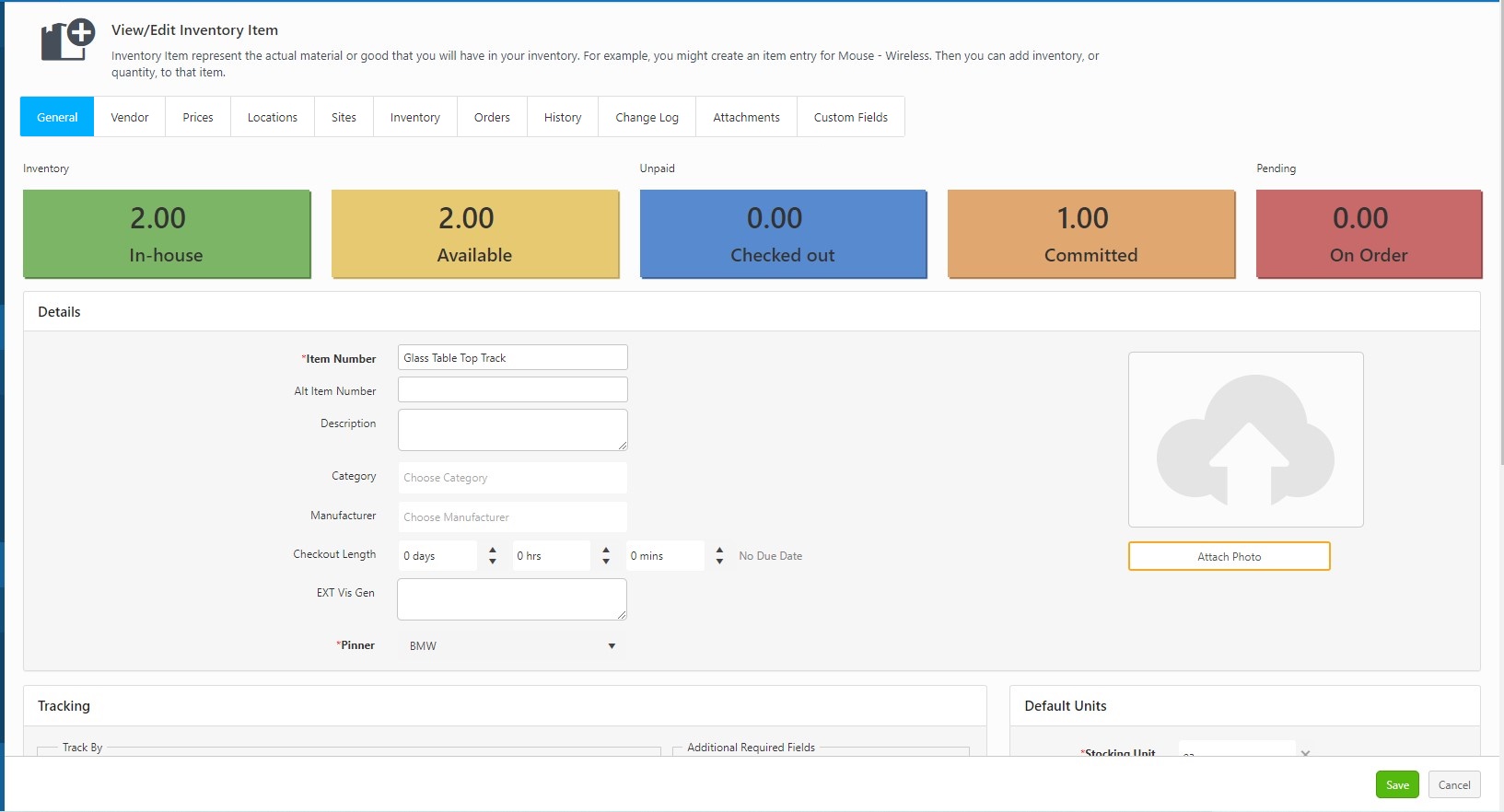
- Edit the fields that require an update.
The View/Edit Inventory Item screen will have three additional tabs - Inventory, Orders, Change Log, and History. Also, the screen will have the following colored boxes:
- In-house - indicates how many items you have.
- Available - indicates In-house quantity- Checked out quantity.
- Checked out - indicates how many are currently loaned out.
- Committed - indicates how many are on pick orders but haven’t been picked yet.
- OnOrder - indicates how many are on purchase orders that haven’t been received yet.
Refer to Adding a New Inventory Item - General Tab, Vendors Tab, Prices Tab, Locations Tab, Sites Tab, and Attachments Tab for more details.
The Inventory tab will display the item's site, location, and quantity details. Hence the page will display all the Sites, Locations, Container ID, Total In-House, Total Checked Out, and Total Available details. Note: The container feature is scheduled for a future release.
- Show Filter checkbox allows you to narrow down the displayed results to a range of items or a specific item.
- Group By checkbox allows you to group the columns. Depending on how you want to view your information, you can have one group, two groups, or many groups.

The Orders tab will list the purchase orders, pick orders, and process orders associated with the item. The orders tab will display the Order Type, Order Number, Order Date, Due Date, Order Status, Unit, Ordered Quantity, and Processed Quantity.
- Show Filter checkbox allows you to narrow down the displayed results to a range of items or a specific item.
- Group By checkbox allows you to group the columns. Depending on how you want to view your information, you can have one group, two groups, or many groups.

The Order Number is a link that will navigate to the View/Edit POs screen / View/Edit Pick Order screen/ Build Assembly screen.
- Build - Refer to Build Assembly for more details.
- View /Edit POs (Purchase Order) - Refer to the View/Edit Purchase Order for more details.

- View/Edit Pick Orders - Refer to the View/Edit Pick Orders for more details.

The History tab will display all the transactions related to the inventory item. It will display the Transaction Date, Transaction Type, Site, Location, Container ID, Quantity, Customer, Vendor, User Transaction Date, Has Notes, and Has Signature. Note: The container feature is scheduled for a future release.
- Show Filter checkbox allows you to narrow down the displayed results to a range of items or a specific item.
- Group By checkbox allows you to group the columns. Depending on how you want to view your information, you can have one group, two groups, or many groups.
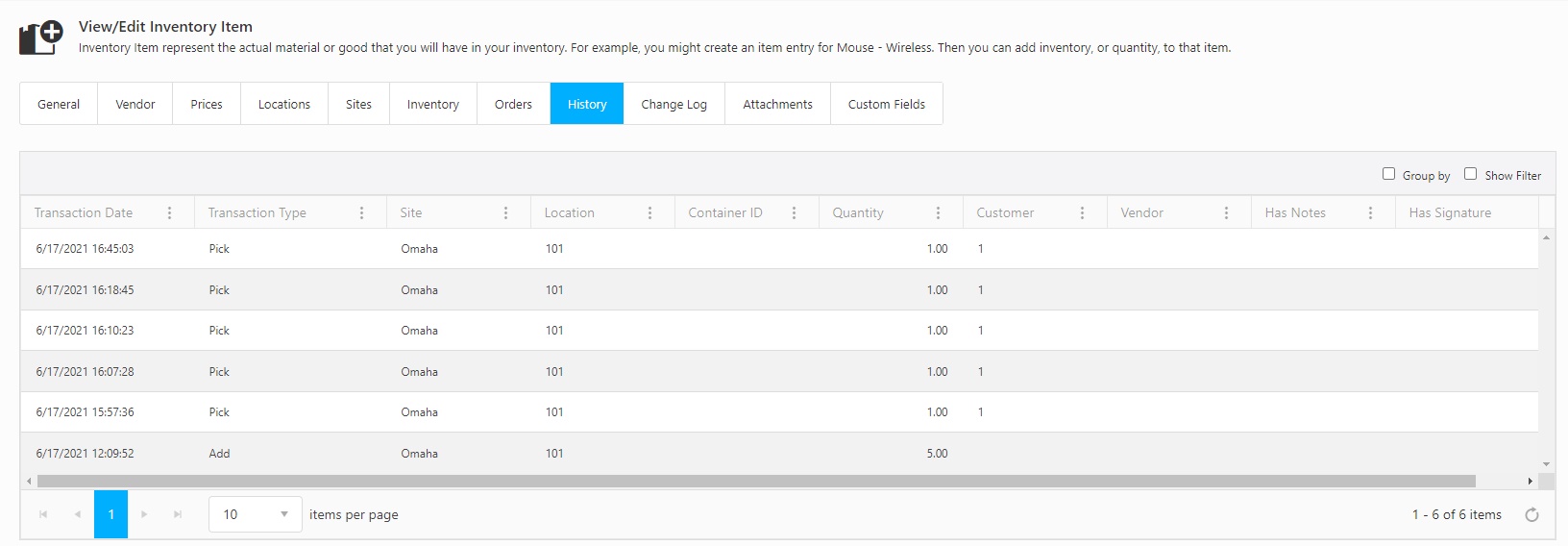
Deleting an Inventory Item
- To delete an Inventory Item, Click on Item > View Items.
- Search for an inventory item that you want to delete.
- Select the checkbox next to the item number and click on the Delete button. A confirmation screen will appear. Click on the Delete button again.

Note: You cannot delete an item that is included in a Kit or a Bill of Material. A message "All Items could not be deleted" will appear on deleting.